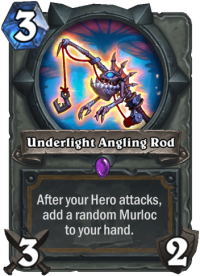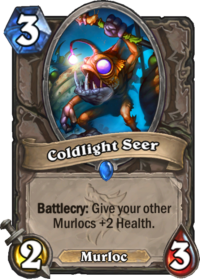Our Murloc Paladin deck list guide for the Ashes of Outland expansion will teach you how to play this budget list. This guide includes Mulligans, Gameplay Strategy, Card Substitutions, and Combos/Synergies!
Introduction to Budget Murloc Paladin

Let me start with one thing – Murloc Paladin is a better deck than I’ve expected. After the upcoming round or nerfs, it might actually become more popular and make a bigger impact on the meta. However, this budget version is missing a few key cards. I had to adhere to our own budget rules and limit myself to two Epics, no Legendaries and no Adventure cards, making the deck much weaker. Good news is that even the full build is not very expensive. You should be able to build it within 5k Dust (+some gold/real money for 3rd wing of Galakrond’s Awakening).
Murloc Paladin is not a new concept – for some reason, Blizzard likes to give Uther Murlocs and Murloc synergies. It never made much sense, but that’s how it is. Similar decks were viable a few times in the past. It’s a board-centered, aggressive deck which relies on the snowball potential of Murloc tribe. The more Murlocs you play, the stronger other Murlocs become (usually gaining some stats). The deck is rather simple and straightforward, but there’s still some strategy to it, especially with resource management.
Check out Hearthstone Budget Decks & Guides for All 10 Classes!
Budget Murloc Paladin Mulligan Guide
Higher Priority (Keep every time)
- Imprisoned Sungill – Early game MVP of the deck. I have underestimated the card before release, but the fact that it creates 3 bodies at once is great in a Murloc build.
- Murloc Tidecaller – It has always been the premium 1-drop in Murloc builds – it grows out of control very quickly.
- Underlight Angling Rod – Amazing card – it’s almost like a 3 mana 3/2 weapon with “draw 2 cards”, similar in power to Ancharrr (1 more attack, but you get random Murlocs, which might be worse than what you put in your deck), but for Murloc decks.
Lower Priority (Keep only if certain conditions are met)
- Murmy – Keep only if you don’t have other (better) 1-drops. You really want to have a 1-drop opener, but if you already have Sungill and/or Tidecaller, don’t keep it.
- Murloc Tidehunter / Fishflinger – Keep if you already have a 1-drop. I can’t stress it enough, opening with a 1-drop is very important.
- Coldlight Seer – Keep with Sungill. Since it wakes up on Turn 3, on-curve Seer will be really good, guaranteeing buffs on 3 minions. 2x 2/3 + 2x 1/3 on Turn 3 is a great board (even better if you played some Murloc on T2 and it survived).
Budget Murloc Paladin Play Strategy
Like I’ve mentioned already, your play strategy is rather straightforward. You want to flood the board with Murlocs, buff them and then try to kill the opponent. However, your opponents will do their best to prevent you from doing that. Yes, they will clear every Murloc you play whenever they can – even more so than any other tribe.

In the budget version, killing your opponent will be a bit harder, since you’re missing a Murloc Warleader. With our 2 Epics limit of budget decks, I had to pick between him and Underlight Angling Rod, and I believe that Rod is sligthly better. It’s a great combination of early game board control and value, while it can also be used as a “burn” damage later in the game. It’s the reason why you don’t run out of cards, and running out of cards is a really bad thing in this meta (if you play against Demon Hunter, they won’t really run out of cards, and slower decks run enough removal to handle DH).
In faster matchup, you really need to focus on the tempo. Try to play on the curve and put as much stats on the board as possible each turn. For example, dropping a Turn 3 Seer with no other Murlocs on the board is a better idea than just Hero Powering. Yes, it’s just a 2/3 for 3, but it’s better than having a 1/1 on the board. Once you fall behind, you won’t likely come back. The deck does run Consecration, which might come handy at times in those matchups (e.g. it’s really good against Demon Hunter), but unless you also have some minions on the board, you’re just going to spend a turn coming back and your opponent will develop again. However, if you manage to stay at least even on the board, you should be able to push the game in your favor. You play a lot of buffs, which are a great way to swing the game around. Try to buff minions which can already attack and get some good trades with them. In particular, an early Hand of A'dal can swing the game in your favor. For example, you might clear your opponent’s 1-drop with your own 1-drop while keeping it alive and well.

In slower matchup, your line of thought is a bit different. While you still want to play on the curve and get as much tempo as you can (especially in the early game, before AoEs come into action), you won’t have to fight against your opponent’s minions as much as against their removals. Yes, when they drop something you can try to trade it efficiently, but the point is that you will be ahead on the board most of the time. Now what’s important is knowing what kinds of AoEs your opponents play to play around them efficiently. For example, if it’s Turn 5 and you play against Galakrond Warlock, you might expect a Crazed Netherwing – 3 damage AoE. So what you might want to do is try to buff as many minions as you can out of the 3 damage range (e.g. with Coldlight Seer, or buff a single one out of range with Blessing of Kings). At the same time, you might want to calculate how much he can deal with Dark Skies (based on the number of cards in his hand) and also try to get your minions out of that range.
If you already have a solid board, you don’t want to play further into the AoE, but there are still a few things you can do instead. You can set up a Imprisoned Sungill (since it survives AoEs until it wakes up), you can play Murmy/Hench-Clan Hogsteed thanks to their Reborn/Deathrattle, you can drop Salhet's Pride, because even if it dies you will get 2 cards back for your trouble. Or you can just equip a weapon and smack your opponent with it. That’s a good way to put more pressure without playing minions.
Ultimately, weapons will be an important part of your deck and often a way to finish off matches. Early you will most likely use them for board control, but later, especially against slower decks, they will serve as a great way to damage your opponent without them being able to do much about it. Angling Rod in particular is strong, because you can smack and it will give you more value, but Truesilver Champion deals more damage. Hoard Pillager gives you a way to get your weapon back – usually Angling Rod – while also adding a 4/2 body to the board. With let’s say a Rod into Pillager curve, you will have value for days and you won’t likely run out of cards. And given that random Murlocs can also be from other classes, there’s a chance you will get an Underbelly Angler or Scargil, both of which are great. Not to mention that you might also get Murloc Warleader, which this budget build doesn’t have (although I strongly recommend getting it).
Future Card Replacements for Murloc Paladin
Like I’ve said at the beginning, the build is missing a few cards, but all in all even the full version is not that expensive. Here are the cards you want to put in to really make it work on the ladder, even in higher ranks:
- 1x Murgur Murgurgle – A solid 2-drop that shuffles an even better card into the deck. 2 mana 2/1 Murloc with DS is playable by itself, and then getting the upgraded version is an amazing board refill. Definitely an Murloc Paladin staple.
- 2x Murloc Warleader – Warleaders are very good offensive Murloc cards. They can either let you trade up your small minions or push more face damage. Dropping a Warleader with a few Murlocs on the board is a great way to set up lethal too.

- 2x Scalelord – A Galakrond’s Awakening card. While not a Murloc by itself, it has insane Murloc synergy. Giving all of your Murlocs Divine Shield makes your board so much stickier and harder to remove. Playing it on 3-4 Murlocs board, ESPECIALLY with Warleader in there, will often win you the game. Oh, and it’s a 5 mana 5/6, so dropping it on curve won’t be the end of the world even without multiple Murlocs.
- (Optional) – Sir Finley of the Sands – You can cut one of the Murloc Tidehunters to add Finley instead. Why? Not for its effect, of course (but it MIGHT be activated once every X games), but because 2/3 is generally better than 2/1 + 1/1. But it’s only a very minor improvement.
And here are the cards you can cut:
- 1x Toxfin (at least right now, there aren’t many big minions in the meta, so a single Toxfin is enough)
- 2x Salhet's Pride – A filler card.
- 2x Blessing of Kings OR 2x Consecration – which one you cut depends mostly on the meta you face. If you face slower decks, cut Consecration. If you face more aggressive/board flood decks, cut Blessing of Kings.
















/rating_1_half.png)
/rating_2_off.png)